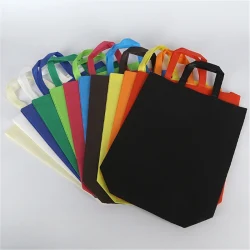Applications of Non-woven Bags
2024-05-31
Non-woven bags are versatile and eco-friendly alternatives to traditional plastic bags, offering a range of benefits such as durability, reusability, and sustainability. Here's an overview of non-woven bags, including their features, benefits, applications, and environmental considerations:
Features of Non-woven Bags
1. Material Composition: Non-woven bags are made from synthetic or natural fibers that are bonded together through various processes such as heat, chemical, or mechanical bonding. Common materials include polypropylene (PP), polyester (PET), and biodegradable fibers such as bamboo or jute.
2. Strength and Durability: Despite being lightweight, non-woven bags are strong and durable, capable of carrying heavy loads without tearing or breaking. The bonded fibers provide structural integrity, making them suitable for repeated use.
3. Soft Texture: Non-woven bags have a soft, fabric-like texture that is comfortable to touch and handle. This makes them ideal for carrying groceries, shopping items, or personal belongings without causing discomfort to the user.
4. Customization Options: Non-woven bags can be customized in terms of size, shape, color, and design to meet specific branding or promotional needs. They can be printed with logos, slogans, or graphics to enhance brand visibility and marketing efforts.
5. Water Resistance: While not completely waterproof, many non-woven bags offer some level of water resistance, protecting the contents from light rain or spills. Water-resistant coatings or laminations can be added for increased protection.
6. Reusable and Washable: Non-woven bags are reusable and washable, allowing them to be used multiple times and easily cleaned between uses. This promotes sustainability and reduces waste compared to single-use plastic bags.
7. Environmentally Friendly: Non-woven bags are considered environmentally friendly alternatives to single-use plastic bags because they are reusable, recyclable, and biodegradable (depending on the materials used). They help reduce plastic pollution and conserve natural resources.
Benefits of Non-woven Bags
1. Sustainability: By encouraging reuse and reducing reliance on single-use plastic bags, non-woven bags contribute to environmental sustainability and conservation efforts.
2. Cost-effectiveness: While non-woven bags may have a higher upfront cost than plastic bags, their durability and reusability make them cost-effective in the long run, as they can be used multiple times.
3. Brand Visibility: Customized non-woven bags serve as walking advertisements, promoting brand awareness and recognition whenever they are carried in public spaces.
4. Versatility: Non-woven bags are suitable for a wide range of applications, including grocery shopping, retail packaging, promotional giveaways, event marketing, and personal use.
5. Consumer Appeal: Many consumers prefer non-woven bags over plastic bags due to their eco-friendly properties, durability, and aesthetic appeal.
6. Regulatory Compliance: Non-woven bags may comply with regulations and initiatives aimed at reducing single-use plastics and promoting sustainable alternatives in various regions.
Applications of Non-woven Bags
1. Retail and Shopping: Non-woven bags are commonly used by retailers for packaging and carrying purchased goods. They can be customized with store logos or promotional messages to enhance branding.
2. Promotional Giveaways: Non-woven bags are popular promotional items at trade shows, conferences, and events. They serve as useful and eco-friendly giveaways that promote brand awareness.
3. Grocery and Produce Bags: Non-woven bags are suitable for carrying groceries, fruits, vegetables, and other food items from stores to homes. They offer durability and strength for carrying heavy loads.
4. Tote Bags and Handbags: Non-woven tote bags and handbags are fashionable accessories that can be used for everyday activities such as commuting, errands, or leisure outings.
5. Travel and Leisure: Non-woven bags are convenient for travel purposes, such as carrying essentials, toiletries, or souvenirs. They are lightweight and foldable, making them easy to pack and carry.
6. Gift Packaging: Non-woven bags can be used for gift packaging, providing an attractive and reusable alternative to traditional wrapping paper or gift bags.
Environmental Considerations
1. Recyclability: While non-woven bags made from certain materials such as polypropylene (PP) or polyester (PET) are recyclable, others may not be readily recyclable due to their composition or manufacturing process.
2. Biodegradability: Some non-woven bags are made from biodegradable fibers such as bamboo or jute, offering an eco-friendly option that breaks down naturally in the environment over time.
3. Resource Consumption: The production of non-woven bags requires energy and resources, including raw materials, water, and electricity. Choosing materials with lower environmental impact and eco-friendly manufacturing processes can help mitigate resource consumption.
4. Waste Management: Proper disposal and recycling of non-woven bags at the end of their life cycle are essential for minimizing environmental impact and reducing waste accumulation in landfills or natural ecosystems.
5. Reusable Habits: Encouraging consumers to reuse non-woven bags and adopt sustainable shopping habits can help maximize their environmental benefits and promote a circular economy.
Conclusion
Non-woven bags offer a sustainable, durable, and versatile alternative to single-use plastic bags in various applications. With their customizable design options, strength, and eco-friendly properties, they are suitable for retail packaging, promotional giveaways, grocery shopping, travel, and more. By considering factors such as material composition, durability, customization options, and environmental impact, businesses and consumers can make informed choices about using non-woven bags as part of their sustainable lifestyle practices.



